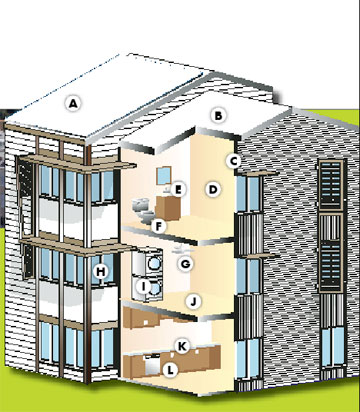Volume 29 · Number 2 · Winter 2012
UC Davis West Village: Under the hood
Energy-efficiency measures at UC Davis's newest neighborhood include solar-reflective roofing, radiant barrier roof sheathing and extra insulation. Energy-efficient exterior lighting fixtures, indoor occupancy sensors and "daylighting" techniques will help the community use about 60 percent less energy than if standard lighting had been used.
A four-megawatt photovoltaic system is expected to meet the energy needs of the first 1,980 apartment residents and commercial spaces. Also planned is a biodigester, now under development, that would convert campus table scraps, animal and plant waste into energy.
The biodigester underscores the influence UC Davis researchers have had on the development. Campus planners relied heavily on faculty from several departments in seeking out the latest energy-efficiency technologies and practices for the community.
Another innovation on the way is the GreenWave home energy management system. This allows residents to monitor energy usage by unit and turn lamps and other plugged-in devices on and off remotely via smartphones. West Village would be the first community in the nation to use it.
West Village includes an extensive bike network and is served by the campus's student-run Unitrans bus service (the buses are powered by compressed natural gas.) Drought-friendly landscaping, water-saving toilets, recycled building materials, and paints low in volatile organic compounds are just some of the green features incorporated into the design.

(Illustration by Jay Leek, UC Davis,based on a rendering provided by Carmel Partners)
Residential unit features
A Solar panels cover much of the roofs and uncovered areas are light in color to reflect heat.
B Radiant barrier roof sheathing keeps inside temperature consistent.
C Upgraded insulation provides greater protection than industry standard insulation.
D Low-VOC (volatile organic compounds) paint. VOCs are poisonous chemicals that can cause disease and air pollution.
E Low-flow faucets
F Low-flow toilets
G Ceiling fans
H Oversized windows for natural light
I Energy Star appliances
J Floor material 50 percent recycled
K Eco-quartz countertops
L Low-VOC finish on cabinets
Back to UC Davis West Village main story
